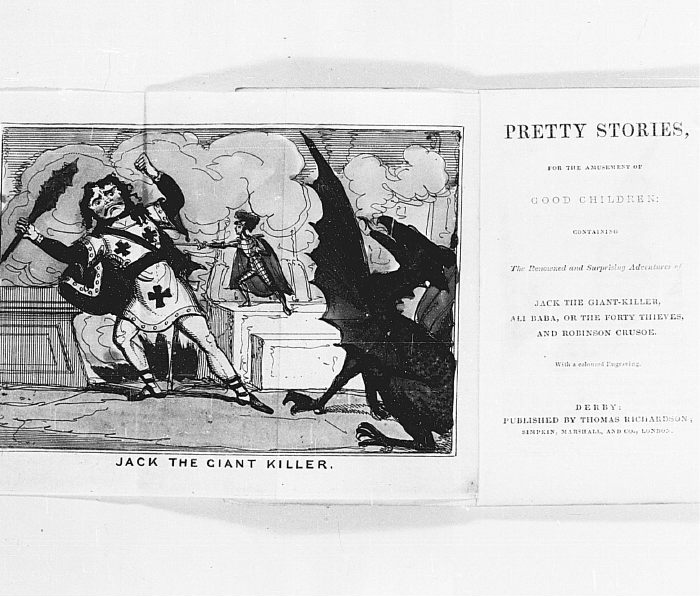Fables and Fairy Tales. 0037: Pretty Stories for the Amusement of Good Children
| Author: |
Various |
| Title: |
Pretty stories for the amusement of good children: containing The Renowned and Surprising Adventures of Jack the Giant-Killer, Ali Baba, or the Forty Thieves, and Robinson Crusoe; With a coloured engraving |
| Cat. Number: |
0037 |
| Date: |
No date but c.1834 |
| 1st Edition: |
|
| Pub. Place: |
Derby |
| Publisher: |
Thomas Richardson [and Simpkin, Marshall, and Co., London; S. Horsey, Portsea; and all other booksellers] |
| Price: |
6d |
| Pages: |
3 vols. in 1, 12 + 12 + 12pp. |
| Size: |
14.5 x 8 cm |
| Illustrations: |
One fold-out engraved frontispiece |
| Note: |
|
Images of all pages of this book

Introductory essay
Each of the three stories contained in this volume have been abridged in a fairy standard manner. Jack the Giant-Killer is a traditional tale of ambiguous provenance, although it was probably not in print in its modern form until the eighteenth century (see essay accompanying 0023). Robinson Crusoe derives, of course, from Daniel Defoe's novel, first published in 1719. Ali Baba, or the Forty Thieves first appeared in Antoine Galland's translation into French of the Arabian Nights, begun in 1704. Though Ali Baba has become perhaps the most famous story in the Arabian Nights, it was not included in the original Arabic Manuscripts which Galland is assumed to have used for his translation, and his source is not known. Ali Baba became popular as a tale for children in the early nineteenth century. Benjamin Tabart, for example, printed a version in his series of Popular Stories for the Nursery (1804-1809: see essay accompanying 0043.)
Judging be the individual title-pages for the three stories in the volume, each was originally intended for separate publication. Presumably the publisher, Thomas Richardson of Derby, brought out the three tales together under the title Pretty Stories for the Amusement of Good Children in an attempt to secure a new market for his wares. It is possible that the tales, when issued separately as chapbooks, were designed for general consumption, that is to say for any adult or child who could afford the price - presumably just a penny or two since the three tale together cost only sixpence. When bound together, Richardson might have intended the volume specifically for well-to-do children - as is suggested by the volume's title and the advertisement on the outside back cover for 'Approved Schoolbooks' and penny battledores. In collecting the three tales together, Richardson cut the coloured engravings for both Robinson Crusoe and Ali Baba, which are still promised by their individual title-pages. Richardson's imprint is usually undated, but some of his publications bear a date, the earliest I have seen being 1828 and the latest 1837.
For other versions of Robinson Crusoe and its variants in the Hockliffe Collection see 0080, 0093 and 0166, and for a discussion of the development its development in British children's literature see the essay accompanying 0080. For other versions of Jack the Giant Killer see 0020, 0022, 0023, 0032, 0036. For another version of Ali Baba see 0004.



